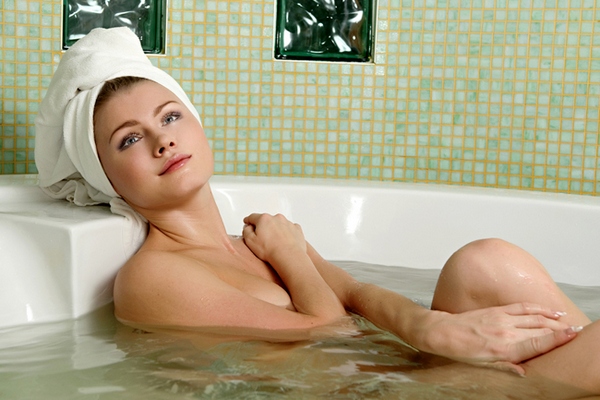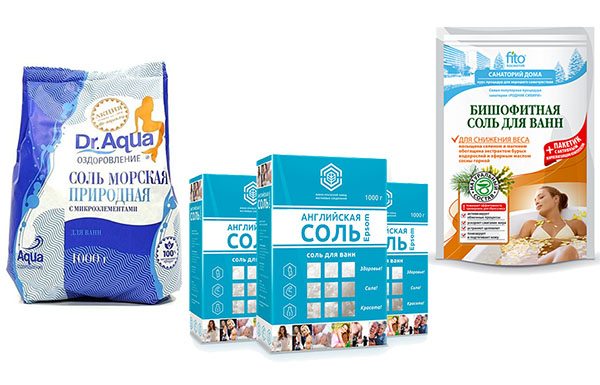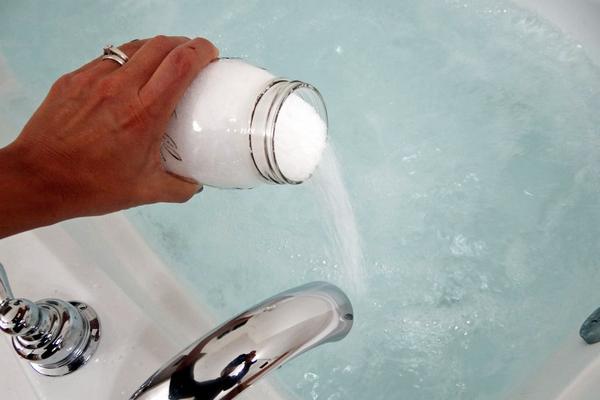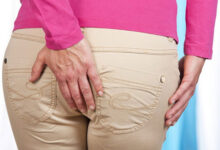- Procedure and promised results
- How it works
- When you shouldn’t take baths
- Summing up
Amongst a variety of home spa treatments, a hot bath with salt enjoys the greatest popularity. Indeed, it is budget-friendly and effective: half a kilogram to one kilogram of salt, 10-20 minutes of time – and half a kilogram of lost weight, as well as hardened hair and nails, and an accelerated metabolism. Is it true? Let’s study the matter.
Procedure and promised results

So, how to take a bath with salt to reduce weight:
- Take a shower and apply a scrub.
- Dissolve 500 to 1000 g of salt in a filled bath. The water level should be sufficient to immerse the body in it without covering the heart area. Water temperature should be 36-39 degrees. Stay in the bath designed for weight loss for 10 to 20 minutes, depending on your health status.
- Wipe yourself dry with a towel without rinsing, cover yourself with a blanket or a plaid, and relax for at least half an hour.
- Refrain from eating for 2 hours before and after the procedure. You can drink.
- Perform a course of 10-15 procedures.
You can use both sea salt and table salt. Most sources advise against using evaporated salt, as it is believed to have an altered structure and no useful elements. The recipe may vary. For example:
- Baths with Epsom salt: mix 100 g of magnesium sulfate (Epsom salt itself) with regular or sea salt in a ratio of 1 to 5;
- Salt-soda baths: 500 g of salt + 250-500 g of soda (we have previously mentioned the effectiveness of soda baths for weight loss);
- Baths with essential oils: add a few drops of essential oil to the salt before dissolving it in the bath. Grapefruit, orange or cedar oil will do.
What salt baths promise
Here are the promised results of a slimming bath at home:
- weight loss of 300-500 g at a time;
- hardened nails and hair;
- elimination of toxins and waste products;
- elimination of excess cholesterol;
- normalization of hormonal balance thanks to “useful microelements,” which allegedly “penetrate the body through the skin”;
- disappearance of stretch marks and cellulite.
It sounds great and promising. But what actually happens?
How it works

To understand the operating principle of a bath with salt for weight loss, it is necessary to delve into chemistry.
Lyrical digression
If two solutions of different concentrations are separated by a selectively permeable membrane, meaning that only solvent molecules can pass through it, the solvent will move toward the solution with a higher concentration of the dissolved substance. This process is called “osmosis,” and the pressure created this way is called osmotic.
It is osmotic pressure that ensures the elasticity of tissues in all living organisms and regulates water exchange between cells and extracellular space. The membrane of any cell is, in fact, a selectively permeable membrane: water molecules penetrate it by means of regular diffusion, while all other substances penetrate it only through special channels with the help of carrier proteins.
A solution with the osmotic pressure equal to that of human blood plasma is called isotonic. Greater osmolarity – hypertonic, lower – hypotonic. All intravenous infusions (droppers) are isotonic so as not to cause destruction of blood cells due to dehydration or, on the contrary, excessive water intake.
Back to slimming baths
Chemically, salt is sodium chloride. And the bath solution is ultimately based on exactly that: sodium ion and chloride ion, regardless of whether it’s a bath with common salt from the nearest grocery store or something more exotic. Yes, natural sea salt will also contain iodine ions (by the way, just like ordinary iodized salt), magnesium, potassium, bromine, and other impurities. Some of them, for example, Dead Sea salt, will contain more of these elements. Some of them, obtained through evaporation, will contain a minimum amount of impurities.
Dissolving the recommended amount of salt in a regular bath filled halfway or even one third (to prevent water from reaching the heart area) results in a hypertonic solution in the bath. It starts drawing out intercellular fluid from the skin that has been carefully treated with a scrub (to cleanse the pores).
Such water loss is not dangerous in itself. If the human body were so susceptible to fatal dehydration, the mankind would have ceased to exist after the first sea bath. However, a bath with sea salt, like any other, will provide some benefits. At least less than promised.
Will the edema go away?
Yes, due to the removal of excess water, including sweat, as 38 degrees is already warmer than the body needs.
Will cellulite disappear?
Possible: exfoliation before taking salt baths, removal of excess fluid, active massage with a terry towel, and so on, repeated 10-15 times – an excellent course of anticellulite treatments.
Stretch marks?
Not likely; very fresh ones may decrease, but old scars are basically scars, and removing them requires other methods.
Will nails grow stronger?
Possibly; salt baths with a strong solution are a folk remedy for brittle nails, although no one ever collected statistics on this issue. Hair – definitely not.
Will cholesterol be removed?
No, its molecule is too large to penetrate the skin.
As for toxins and waste products, everyone talks about them, but no one can say exactly what is meant by these terms.
Thus, there can be no talk about any penetration of beneficial microelements through pores, as it will be water and not salt that will move out of the body.
When you shouldn’t take baths

Like any physiotherapeutic procedure, salt baths designed for weight loss have their contraindications:
- wounds and abrasions on the skin;
- chronic cardiovascular insufficiency;
- dry, sensitive skin;
- lactation – dehydration may reduce milk production;
- malignant tumors;
- elevated body temperature.
Salt baths should be taken with caution during pregnancy: exposure to hot water can provoke miscarriage. However, it is not contraindicated to expose yourself to water of a comfortable temperature during pregnancy.
The same applies to those suffering from hypertension or varicose veins: overheating is contraindicated for them, but water treatments are generally not prohibited. Avoid the varicose veins area when drying the body after a bath.
Summing up
So, what is the bottom line? Improved well-being after a pleasant water treatment. Elimination of edema. Improved skin condition. Reduced food intake is possible if the procedure is performed before bed (you cannot eat for two hours before taking a bath). A slight weight loss due to dehydration, which will disappear as soon as the water-salt metabolism returns to normal. That’s all the results.
Baths can be used as an auxiliary means to relax and tighten the skin a little, especially during weight loss. But it makes no sense to count on more.
See also: “Salt Wraps for Weight Loss”.



